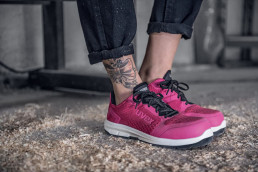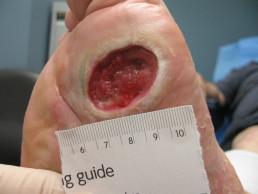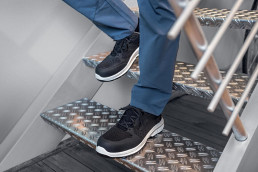Shoes are our constant companions – both in our leisure time and at work. But the perfect fit plays an important role, especially for safety shoes. If you wear shoes that are too wide or too tight at work, this will affect both the protective effect of the safety shoes and the health of your feet. In this blog post, we discuss in detail the need for perfectly fitting safety shoes and outline potential foot problems.
Comfortable work shoes
Workers who have to wear safety shoes every day complain extremely frequently about foot pain and foot problems. A study has shown that 55% of 358 miners suffer from foot problems, with 57% of the issues due to their safety shoes. Poorly fitting safety shoes are one of the main reasons for the unacceptably high level of discomfort among miners, which is three times higher than in the general population.
Foot shapes vary enormously within the population, with significant differences in the ratio of length, width and arch height of the foot. In addition to this degree of variation, the foot shape is dynamic and changes during the walking cycle. With each step, the height of the arch of the foot changes by 33%, with both the length and width of the foot changing accordingly. The change in foot shape during the walking cycle also varies significantly between individuals. These differences in foot shape and dynamic changes during the walking cycle make correctly fitting safety shoes so important.

Shoes that are too tight – consequences for foot health
Safety shoes that are too small can result in serious foot problems. Tight shoes can cause nerve entrapment in the foot, which can lead to pain, discomfort and numbness. Wearing shoes that are too tight for long periods of time can also damage the intermetatarsal nerves (metatarsus) and lead to the development of a relatively common benign fibrous tumour – Morton’s neuroma.
Morton’s neuroma
Morton’s neuroma is characterised by sharp, burning and radiating pain. The pain is often infrequent at first, but then becomes chronic as the condition worsens. Morton’s neuroma frequently requires surgery to relieve symptoms if conservative treatment fails.
Chafing and blistering
Shoes that are too tight are also more likely to cause chafing and blistering. While for most healthy people a blister is unpleasant, it usually heals without long-term consequences. In people with diabetes or restricted blood supply to the feet, a blister due to shoes is the main cause of ulcers and leg amputations.
8.4% of the adult population in Germany suffers from diabetes and the figure is similar in other industrialised nations. Properly fitting shoes for these workers could therefore make the difference between losing their leg or being able to continue walking and maintain their mobility.
Peripheral neuropathy
A common complication of diabetes is a condition called peripheral neuropathy, which leads to a loss of sensation and the inability to perceive pain. The loss of sensation means that these people are unable to feel if their safety shoes are fitting properly or if a blister has already started to form, which can then lead to ulcers and possible amputation. For workers with peripheral neuropathy, it is important that their safety shoes fit properly to minimise the risk of serious health complications such as ulceration and amputation.
The majority of healthy workers would notice that their safety shoes are too tight when they try them on because of the immediate discomfort.

Periphere Neuropathie
Eine häufige Komplikation bei Diabetes ist eine als periphere Neuropathie bezeichnete Erkrankung, welche zum Verlust des Gefühls und der Schmerzwahrnehmung führt. Das Fehlen des Empfindungsvermögens bedeutet, dass diese Menschen nicht in der Lage sind zu fühlen, ob die Sicherheitsschuhe richtig sitzen oder ob bereits die Blasenbildung begonnen hat, die dann zu Geschwüren und einer möglichen Amputation führen kann. Für Arbeitnehmende mit peripherer Neuropathie ist es wichtig, dass ihre Sicherheitsschuhe richtig passen, um das Risiko schwerwiegender gesundheitlicher Komplikationen wie Ulzerationen und Amputationen zu minimieren.
Die Mehrheit der gesunden Arbeitnehmenden wird aufgrund der unmittelbaren Beschwerden bereits bei der Anprobe der Sicherheitsschuhe feststellen, dass diese zu eng sitzen.
Shoes that are too big – dangers of safety shoes that are too wide
Wearing safety shoes that are too big can also lead to complications. A significant percentage of workers wear safety shoes that are too big for them so that they can wear the necessary width. It is therefore more common for people to wear safety shoes that are too large rather than too tight.
Slips, stumbles or falls
Shoes that are too long represent a tripping hazard because the length of the safety shoe reduces the ground clearance during the swing phase of the gait cycle. Every fifth occupational accident reported in Germany is due to a slip, stumble or fall. Correctly fitting safety shoes are therefore crucial in minimising the risk of tripping. In addition, the protective function of safety shoes is impaired if they are too long, as the protective toe cap only protects a reduced proportion of the foot from crushing injuries.

Increased fatigue
Safety shoes are designed to flex and move with the foot. But these functional aspects rely on the correct fit of the shoe. A shoe that is too long pushes the MTP joint, which moves 60° when walking, back into a stiffly constructed area of the shoe, which is usually supported with an upper. This inhibits the natural rolling and propulsive function of the foot. Due to the reduced amount of stored elastic energy in the plantar fascia and Achilles tendon, the workload of the calf muscles is increased. The misalignment between the ball of the foot and the flex point increases the torque on the ankle joint and consequently the development of fatigue in the calf muscles during the working day.
68% of workers in the automotive industry suffer from lower limb fatigue. This fatigue costs the American economy $101 billion a year in lost productivity. Therefore, every effort should be made to reduce worker fatigue.
Blistering
Safety shoes that are too loose can also increase the risk of blistering because the shoes do not fit tightly on the foot and movement of the foot in the shoe increases. This is particularly significant for workers who have diabetes and for those with impaired blood supply to the lower extremities due to the potential risk of ulceration.
The uvex fit solutions for safety shoes
Comparing the 3D scans of workers’ feet with that of their safety shoes shows that the majority wear safety shoes that are 1 to 2 sizes too big to accommodate the width they need.
uvex has developed solutions for the foot problems and complaints that can arise from wearing incorrectly fitting safety shoes. The uvex safety shoe range has been developed using a variety of different lasts to offer a choice of various fits to suit both the intended use of the shoe and foot shape.
The uvex multiple fit system offers four widths for many models, to ensure that the right width can be worn for a specific foot length without the shoe being too big. For workers with significant foot deformities or existing medical foot conditions, the uvex motion 3XL orthopaedic safety shoe offers an alternative for those who cannot wear normal safety shoes and would otherwise have to resort to custom-made safety shoes.
uvex multiple fit system – find the right safety shoe size
Finding the right safety shoe size is more difficult than it is for normal shoes. This is due to the lack of flexibility of the hard protective toe cap, which makes it impossible to check the foot position in the shoe.
The uvex multiple fit system was developed to help find the right size and width in uvex safety shoes for the length and width of the foot. Workers’ feet can be measured either by hand with a tape measure and the corresponding size chart or digitally with the uvex size advisor app.
It is not uncommon for the left and right feet to be different sizes. In this case, the larger foot should be measured. The consequences of wearing shoes that are too tight are worse than those of wearing safety shoes that are a little too big.
Read our blog post “How do I determine the right size for my safety shoes? With the uvex size advisor app!” for a step-by-step guide on finding the right safety shoe size.
Foot problems are common among workers who have to wear safety shoes every day, and are exacerbated by ill-fitting safety shoes. Correctly fitting safety shoes can help improve the wearer’s foot health, safety and productivity. It is important to choose both the right length and the right width when trying on safety shoes. The uvex multiple fit system and size advisor app offer quick and effective tools for correctly fitting safety shoes in the workplace and improving workers’ well-being and productivity.